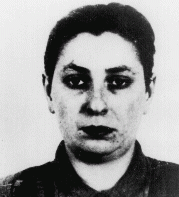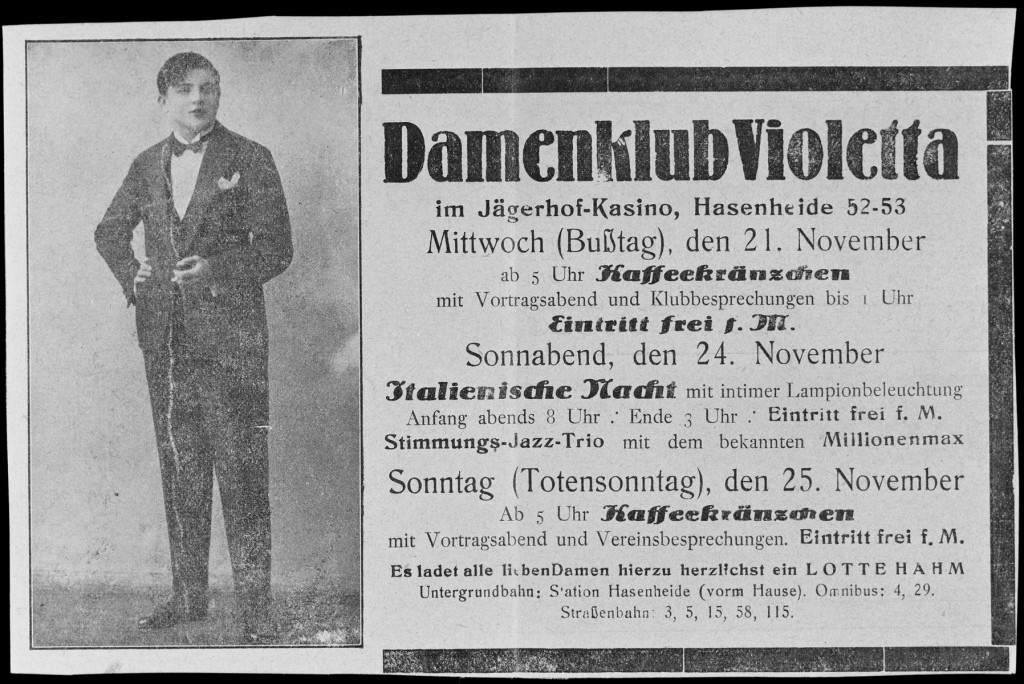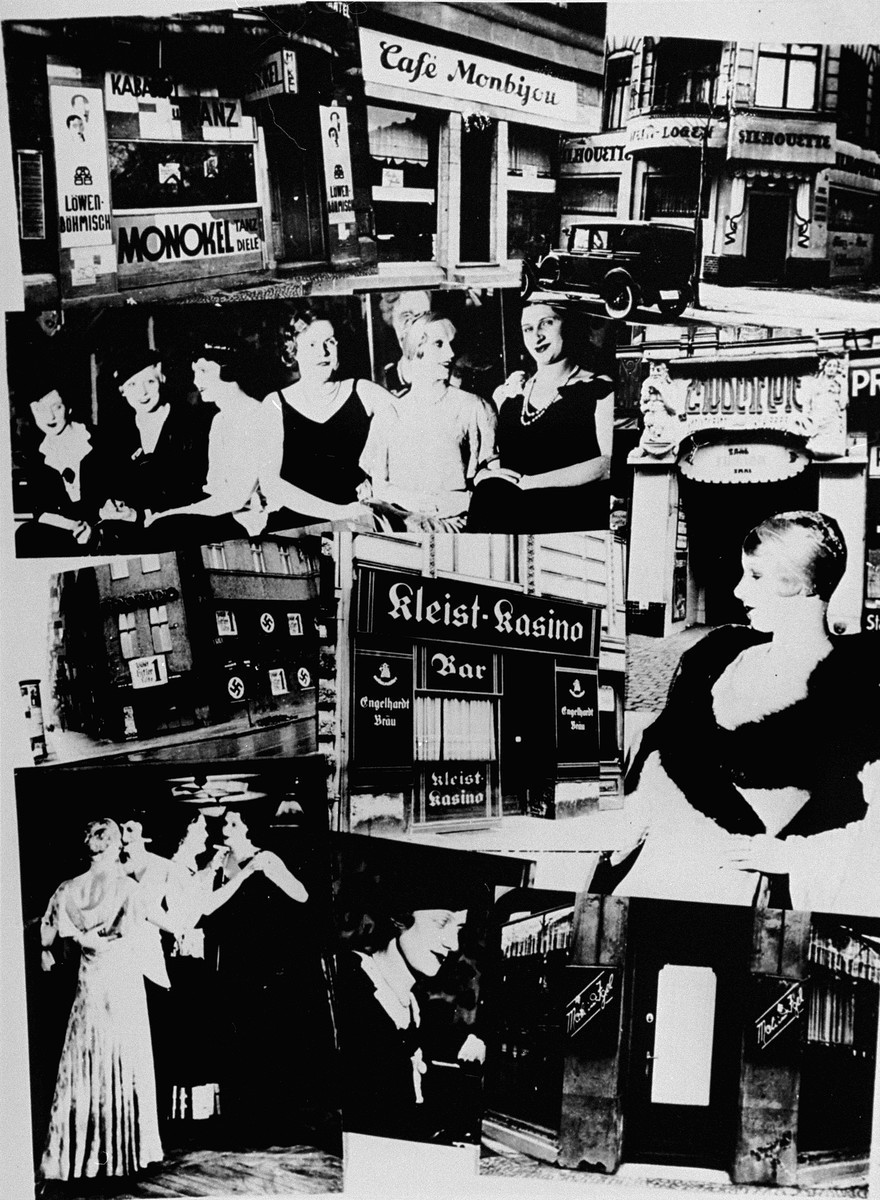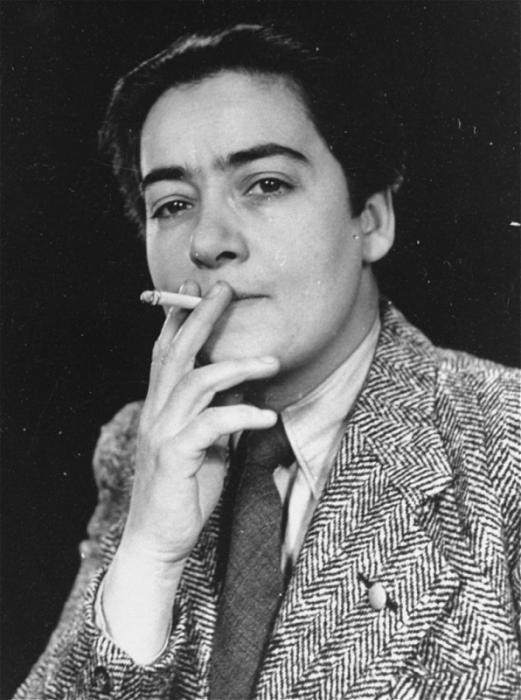
Lesbians under the Nazi Regime
Under the Nazi regime, there was no official law or policy prohibiting sexual relations between women. Nonetheless, beginning in 1933, the Nazi regime harassed and destroyed lesbian communities and networks that had developed during the Weimar Republic (1918–1933). This created a climate of restriction and fear for many lesbians.
Key Facts
-
1
Before the Nazis came to power in 1933, lesbian communities and networks flourished, especially in big cities.
-
2
The Nazi regime treated sexual relations between women differently than sexual relations between men. This was because of how the Nazis understood the role of women in society.
-
3
The Nazis did not systematically persecute lesbians. However, some lesbians were imprisoned in concentration camps as political prisoners, asocials, and as members of other groups.
Introduction

The Nazis did not systematically prosecute or persecute lesbians solely because of their sexuality. Under the Nazi regime, there was no official law or policy prohibiting sexual relations between women. This is unlike the case of gay men.
Before, during, and after the Nazi regime, men accused of homosexuality were prosecuted under Paragraph 175 of the German criminal code. This statute criminalized sexual relations between men. It did not apply to sexual relations between women. Nonetheless, beginning in 1933, the Nazi regime harassed and destroyed lesbian communities and networks that had developed during the Weimar Republic (1918–1933). This created a climate of restriction and fear for many lesbians.
Because there was no single law or policy that applied to sexual relations between women, lesbians had a wide range of experiences in Nazi Germany. These experiences were not solely determined by their sexuality. Rather, other factors shaped lesbians’ lives during the Nazi era. Among them were supposed “racial” identity, political attitudes, social class, and gender norms. Based on these factors as well as others, some lesbians (especially those who were working class) were imprisoned or sent to concentration camps. In these instances, they were classified as political prisoners or asocials. Jewish lesbians largely faced Nazi persecution and mass murder as Jews. In most cases, their sexuality was a secondary factor. The Germans and their collaborators murdered an unknown number of Jewish lesbians during World War II.
Before the Nazis: Lesbians in the Weimar Republic
During the Weimar Republic, German society experienced complex social, political, and cultural transformations. On the one hand, the Weimar Republic was defined by political turmoil and violence. It was also a time of economic distress. On the other hand, Germans had greater political and social freedoms. The atmosphere gave rise to artistic movements, an expanded press, and increasingly visible alternative cultures.
During the Weimar era, Germans publicly challenged gender and sexual norms. This was especially true in big cities such as Berlin, Hamburg, and Frankfurt am Main.
Weimar’s Lesbian Networks and Communities

Distinct lesbian communities developed around this time. Lesbians founded social clubs and associations to foster networks and connections. The most famous lesbian associations were the Violetta and Monbijou women’s clubs (Damenklub Violetta and Damenklub Monbijou) in Berlin. These associations held informal gatherings in lesbian bars and nightclubs, such as the dance club Monokel-Diele. Lesbians also gathered at the famous Eldorado nightclub.
Meeting places advertised in a new lesbian press that emerged in the mid-1920s. Lesbian journals contributed to the growth of lesbian networks. Among them were Frauenliebe (Women’s Love) and Die Freundin (The Girlfriend). In bigger cities, readers could purchase these journals at newsstands. And throughout Germany, readers could subscribe to them by mail. Other types of lesbian literature, including novels, also began to appear more frequently.
German Attitudes towards Homosexuality
Public discussions of sexuality had occurred in Germany since the late 19th century. However, the social atmosphere during the Weimar Republic created more space for these conversations. There were discussions about homosexuality at the time. Physician and sex researcher Magnus Hirschfeld and others organized gay and lesbian “friendship leagues” (Freundschaftsverbände), which also included heterosexual members. These groups advocated for the decriminalization of sexual relations between men. In this endeavor, they found allies on the political left and center. Among the supporters were:
- the large, moderate-left Social Democratic Party (Sozialdemokratische Partei)
- the more radical Communist Party (Kommunistische Partei Deutschlands)
- the pacifist German League for Human Rights (Deutsche Liga für Menschenrechte)
- the centrist German Democratic Party (Deutsche Demokratische Partei)
Hirschfeld and others also sought to educate the public about sexuality. For example, they promoted Hirschfeld’s ideas that homosexuality is inborn and not a vice or perversion.
Large numbers of Germans were opposed to these public discussions of sex and sexuality. They viewed such debates as decadent, overly permissive, and immoral. Many were disturbed by the increased visibility of sex in advertising, film, and other aspects of daily life. For these Germans, gay and lesbian communities were one symbol of what they saw as the degeneration of German society.
Various right-wing and centrist political groups, as well as mainstream religious organizations, sought to counter this aspect of Weimar culture by promoting their own version of German culture. This version was rooted in classical music and literature, religion, and the family. In some cases, these groups blamed others for corrupting German culture. They blamed, for example, Jews, Communists, and Americans.
Nazi Attitudes towards Homosexuality
Even before coming to power, many Nazis resented the visibility of gay and lesbian communities. They condemned homosexuality as a threat to the German people. The Nazi Party officially opposed any efforts to decriminalize sexual relations between men. They argued that homosexuality was a destructive vice. Wilhelm Frick, a Nazi member of the Reichstag, stated in 1927 that “men practicing unnatural lechery between men must be persecuted with utmost severity. Such vices will lead to the disintegration of the German people.”
The Nazi Crackdown on Homosexuality
Adolf Hitler was appointed chancellor of Germany on January 30, 1933. Soon afterwards, Germany’s gay and lesbian communities came under pressure and scrutiny from the new regime. For men accused of homosexuality, this worsened over the course of the 1930s. They faced brutal persecution.
Shutting Down Lesbian and Gay Meeting Places

Beginning in 1933, the Nazi regime began to harass gay and lesbian communities and individuals by shutting down and raiding their meeting places and organizations. At first, Nazi actions were uneven. They depended on the priorities of local government and police officials. For example, in spring 1933, the Nazis ordered the Prussian police to close some bars. Among those closed were the Eldorado in Berlin and the Dornröschen in Cologne. Nonetheless, some established gay and lesbian bars were able to remain open in cities like Berlin and Hamburg until the mid 1930s. Underground meeting places remained open even later. These, however, came under increasing police surveillance. As part of the Nazi regime’s restrictions on the free press, the government also shuttered gay and lesbian newspapers and journals.
By eliminating gay and lesbian gathering places and presses, the regime effectively dissolved the lesbian communities that had developed during the Weimar Republic.
Expanding the Persecution of Men Accused of Homosexuality
Over the course of the 1930s, Nazi actions targeting male homosexuality became more systematically oppressive. In 1935, the Nazi regime reformed Paragraph 175. The statute now criminalized any and all sexual intimacy between men. The Nazis also increased the severity of the punishment for these crimes. They instructed prosecutors to argue for harsh sentences in court. Judges often complied.
Eventually, SS leader Heinrich Himmler took the lead in persecuting male homosexuality, which he called a “public scourge.” In 1936, Himmler created the Reich Central Office for the Combating of Homosexuality and Abortion (Reichszentrale zur Bekämpfung der Homosexualität und der Abtreibung). This office was part of the Kripo (Criminal Police) and worked closely with the Gestapo. One of its main responsibilities was to police and track down men suspected of homosexuality. The police were less concerned with lesbians. However, they did investigate and interrogate some lesbians as well.
Lesbians and Nazi Procreation Policies
The Nazi regime never criminalized sexual relations between women. They considered doing so as part of their efforts to crackdown on homosexuality. However, they did not do so because the regime viewed lesbians differently than gay men. Why was this the case?
The Nazi regime saw lesbians, first and foremost, as women.
The Nazis believed that German women had a special task to perform: motherhood. According to Nazi logic, lesbians were women and should thus be mothers. They had a responsibility to give birth to racially pure Germans, called “Aryans.”
To encourage Aryan procreation, the Nazis adopted a variety of programs and laws. One example is the Lebensborn program. It encouraged Aryan women to have many children, even outside of marriage. At the same time, the Nazi regime tried to prohibit or limit the procreation of other supposedly inferior groups. In July 1933, a new law mandated sterilization of people with supposedly hereditary disabilities. Other laws, such as the 1935 Nuremberg Laws, defined who could have sex with whom.
The Nazis did not create any separate policies that singled out lesbians as a problem for Aryan procreation. Their reasoning drew on widespread attitudes about the differences between male and female sexuality. The Nazis concluded that Aryan lesbians could easily be persuaded or forced to bear children.
Lesbian Responses to the Nazi Regime

During the Nazi regime, lesbians could not continue to live and socialize as they had during the Weimar Republic. Much of German society saw lesbians as social outsiders, meaning people who did not fit into the mainstream. As such, they had a higher risk of being denounced and then targeted by the Nazi regime.
Lesbians responded to these new fears and conditions in different ways. Not all lesbians made the same decisions. Nor did they all have the same choices. For example, Aryan lesbians had far more options than Jewish or Romani lesbians, who—above all—faced persecution for racial reasons.
Aryan lesbians, especially those with financial resources, could try to hide their sexuality and outwardly conform. Some broke off contact with their circles of friends or withdrew from the public sphere. Others moved to new cities or the countryside. Some lesbians also entered marriages of convenience.
There were German lesbians who took the risk of resisting the Nazi state for political and personal reasons. Some continued to seek out underground meeting places, especially in major cities. There were lesbians who joined underground anti-Nazi resistance groups or helped hide Jews.
Arrest and Detention of Lesbians in Concentration Camps
Based on archival sources, it is clear that some lesbians were arrested and sent to concentration camps. What were some of the reasons for their arrest and detention, especially considering sexual relations between women were not illegal under the Nazi regime?
The short answer is that when lesbians were arrested, they were arrested as members of other groups:
- Jews
- Roma
- asocials
- political prisoners
- professional criminals
In lesbian prisoners’ paperwork, camp authorities usually listed a racial, political, social, or criminal reason as the primary cause for their arrest. In a few cases, the authorities also noted their sexuality.
It is difficult to know what role lesbians’ sexuality played in their detention. Sometimes their arrest had little or nothing to do with the fact that they were lesbians. At other times, their sexuality may have played a role. This was especially the case regarding arrests prompted by denunciations. Denunciations frequently affected people considered social outsiders.
Denunciations of Lesbians
Sexual relations between women were taboo for much of German society. Neighbors, family members, and friends sometimes disapproved of and thus denounced the women involved to the police. It is possible they did not realize that sexual relations between women were not illegal. In some of these cases, the police dismissed the complaints because they had no legal basis.
Yet, denunciations could cause unwanted scrutiny for lesbians. Sometimes a denunciation led the police to discover criminal offenses. For example, it could reveal ties to a resistance organization, friendship with Jews, or subversive political behavior. In those cases, women could be arrested and sent to concentration camps.
The Case of Elli Smula and Margarete Rosenberg
The example of Elli Smula and Margarete Rosenberg illustrates how the Nazi regime sometimes arrested women accused of same-sex relations on other charges. In 1940, the Gestapo detained and interrogated Smula and Rosenberg. The Gestapo did so based on denunciations from the women’s coworkers. The coworkers alleged that the two women had engaged in sexual relations with other women. The Gestapo claimed that these sexual relations had interfered with the women’s work duties at a Berlin tram station. Smula and Rosenberg were accused of subversion. They were then deported to the Ravensbrück concentration camp. There, the two women were registered as political prisoners. A notation of “lesbian” was written in their camp documentation.
Lesbians and the Pink Triangle
The Nazis classified prisoners in concentration camps into groups according to the reason for their imprisonment. By 1938, these groups were identified with various colored badges worn on camp uniforms. Men imprisoned for allegedly violating Paragraph 175 had to wear a pink triangle. The badge identified them as “homosexual” (homosexuell) according to the classification system.
In the camps, women who self-identified or were identified as lesbians did not wear the pink triangle. Instead, they wore badges that corresponded to the official reason for their arrest and internment.
Sexual Relations between Women in Concentration Camps
First-hand testimonies, memoirs, and diaries of former prisoners reveal that prisoners had sexual encounters with each other in concentration camps. According to these sources, sexual encounters ranged from consensual intimacies to prostitution to brutal sexual assault. Both heterosexual and same-sex relationships took place in the camps.
Some women engaged in sexual relations with their fellow female prisoners. It is important to note that such relations do not always fit neatly within the category of “lesbianism.” This is because not all women who engaged in same-sex relations were lesbians. Some women developed same-sex relationships and later described them as a source of comfort in the camps. Others even saw them as necessary for survival.
Same-sex relations in the camps could be shocking to other prisoners, who came from a variety of cultures and backgrounds. In postwar memoirs and testimonies, some camp survivors described lesbians in the camps as a threat to the safety and well-being of other prisoners. Others saw same-sex relations as an example of degradation caused by the camp experience. These descriptions reflect the extent to which lesbians often continued to be treated as outsiders in the camps.
Documenting Lesbian Experiences under the Nazis
It remains a research challenge to find historical sources related to lesbian experiences under the Nazi regime.
In cases where lesbians did not come into direct contact with the regime, there is little or no paper trail documenting their lives and experiences.
But even in cases when lesbians were arrested and sent to concentration camps, the records can be hard to find. One of the greatest challenges is that lesbians were rarely identified as such in official records from the Nazi era.
In addition, there was no specific law under which lesbians were prosecuted. Thus, there is not always an obvious place to look for criminal records pertaining to their arrests and detentions. For example, lesbians appear in court cases and police files relating to political opposition or asocial behavior. However, these are scattered across many files and in various archives. Scholars hoping to learn about lesbians’ stories are painstakingly combing through these files.
Another difficulty is that very few lesbians shared testimonies about their experiences during this time. This is partially because the topic of sexual relations between women remained taboo for decades after the Nazi era.
Scholars continue to research the history of lesbian experiences under the Nazis.
Footnotes
-
Footnote reference1.
A German-speaking advocate for the decriminalization of sexual relations between men coined the terms “Homosexualität” (“homosexuality”) and “homosexuell” (“homosexual”) in 1869. While today many members of the LGBTQ+ community consider these terms derogatory, the words “homosexuality” (“Homosexualität”) and “homosexual” (“homosexuell”) were popular and broadly used in the late-nineteenth and twentieth centuries. They gained acceptance among much of the German medical and scientific community. People began to identify as “homosexual” (“homosexuell”) or same-sex oriented (“gleichgeschlechtlich”) in late nineteenth century Germany.
-
Footnote reference2.
Sexual relations between women was a crime in the Nazi-annexed territories of Austria and the Czech lands of Bohemia and Moravia. These laws were already in existence before Nazi annexation and continued to apply throughout the Nazi era.
Critical Thinking Questions
How and why did the Nazi regime target gay men and lesbians?
How did the Nazi persecution of lesbians fit into the broader Nazi worldview?
What can other nations and people do when a civilian group is persecuted in another country?

